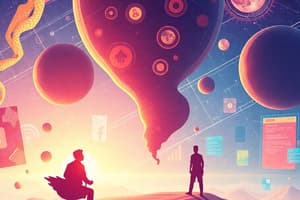Podcast
Questions and Answers
What is the term for a collection of computers connected together?
What is the term for a collection of computers connected together?
- Network (correct)
- Application
- System
- Internet
What does LAN stand for?
What does LAN stand for?
- Limited Access Network
- Large Area Network
- Local Area Network (correct)
- Longitudinal Application Network
What is the main function of a network server?
What is the main function of a network server?
- To store and manage network resources (correct)
- To play video games
- To write documents
- To browse social media
Which of the following is a common networking device that connects multiple devices to a network?
Which of the following is a common networking device that connects multiple devices to a network?
What is the purpose of a network protocol?
What is the purpose of a network protocol?
Flashcards
Text-to-Image AI
Text-to-Image AI
An AI system that generates realistic images from textual descriptions, bridging language and vision.
Diffusion Models
Diffusion Models
Models that can generate high-quality images, offering detailed and coherent visuals.
Stable Diffusion
Stable Diffusion
An open-source image generation model known for its efficiency and customizability.
Image Variation
Image Variation
Signup and view all the flashcards
In-Painting
In-Painting
Signup and view all the flashcards
Study Notes
- The video discusses the concept of the "attention economy," where human attention is a limited resource that is being competed for
The Attention Economy
- Our attention is a valuable and finite resource
- Just like traditional economics studies how resources are allocated, the attention economy studies the competition for our attention
- In the digital age, there's an overwhelming amount of content vying for our focus, making attention a scarce commodity
- This scarcity drives the competition among content creators, platforms, and advertisers to capture and retain our attention
How Attention is Monetized
- Attention is monetized through various means, primarily advertising
- Platforms like social media, search engines and websites sell ad space, and the more attention they can attract and hold, the more they can charge advertisers
- User data is collected and analyzed to target ads effectively, ensuring that the right ads are shown to the right people at the right time
- This data-driven approach maximizes the value of attention by increasing the likelihood of engagement and conversion
- Capturing attention is the first step, but maintaining it is equally crucial for sustained monetization
Strategies for Capturing and Maintaining Attention
- Content creators and platforms employ various strategies to capture and maintain attention
- Creating compelling and engaging content is essential for grabbing initial attention
- Personalization, achieved through algorithms that tailor content to individual preferences, keeps users engaged
- Notifications and alerts are used to draw users back to platforms, creating habitual usage
- Social validation, such as likes, comments, and shares also taps into our need for social connection and encourages continued engagement
- These strategies are designed to make content more appealing and addictive, ensuring that users keep coming back for more
The Impact of the Attention Economy
- The modern attention economy has both positive and negative impacts on individuals and society
- It can lead to increased access to information and diverse perspectives
- Entertainment options and social connections have expanded
- Potential downsides include information overload, which can lead to stress and anxiety
- Filter bubbles and echo chambers can reinforce existing beliefs and limit exposure to different viewpoints
- Privacy concerns arise from the extensive data collection required to personalize content and target ads
- Constant distractions can reduce productivity and focus, affecting both work and personal life
Regulation and Mitigation Strategies
- Concerns about the negative impacts of the attention economy have led to calls for regulation and mitigation strategies
- Increased transparency is needed regarding how platforms collect and use user data
- Stronger privacy laws are necessary to protect individuals' personal information
- Promoting media literacy can help individuals critically evaluate information and resist manipulation
- Encouraging mindful technology use, such as setting time limits and reducing notifications, can improve well being
- These measures aim to balance the benefits of the attention economy with the need to protect individuals and society from its potential harms
The Future of the Attention Economy
- The attention economy is likely to evolve as technology advances and societal values change
- New technologies such as virtual reality and augmented reality may create even more immersive and attention-grabbing experiences
- A growing awareness of the negative impacts of excessive technology use may lead to a shift toward more mindful and intentional engagement
- Alternative models for content creation and distribution may emerge, prioritizing quality over quantity
- As younger generations grow up with technology, their attitudes and behaviors may shape the future of the attention economy
- The ongoing interplay between technology, society, and individual well-being will determine the future trajectory
Conclusion
- The attention economy is a complex and pervasive force in the digital age, transforming how we consume information, interact with technology, and engage with each other
- While it offers numerous benefits, it also poses significant challenges to individual well-being and social cohesion
- By understanding its dynamics and implementing appropriate strategies, we can harness its potential while mitigating its risks
- The key is to promote a balanced and informed approach to technology use, ensuring that attention is directed towards what truly matters to us
Studying That Suits You
Use AI to generate personalized quizzes and flashcards to suit your learning preferences.




